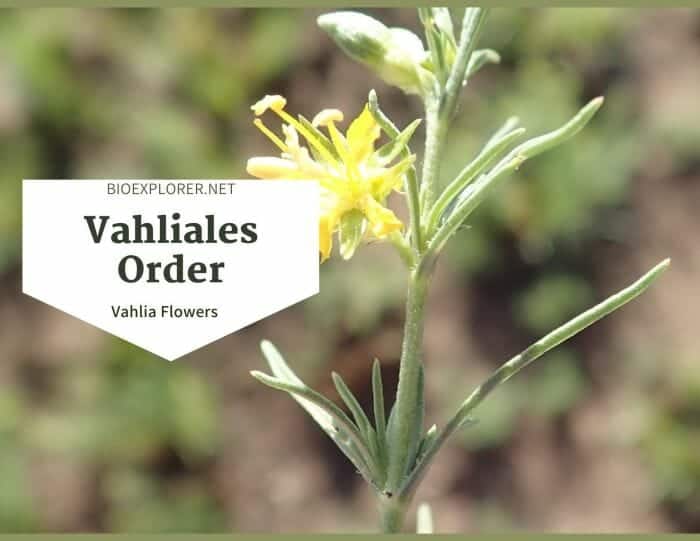
Order Vahliales are erect, branched herbs distributed in Africa and Madagascar to India. The Vahliales plants have simple, opposite, exstipulateWhat is exstipulate?Without stipules; Stipule is a small structure of appendage found at the base of some leaf petioles. leaves, bisexual and paired flowers, pentamerousWhat is pentamerous?Having parts in fives or multiples of five. floral parts, an inferior ovary, and numerous seeds.
The Vahliales order only has a sole family, 1 genus[1] and 5 species[2]. The Vahliaceae is the only family of Vahliales. The APG IV system of classification transferred Vahliacaea from Order Saxifragales to the new order Vahliales.
Table of Contents
Vahliales Distribution
The members of the Vahliales are distributed in Africa and Madagascar to India.
![]()
Vahliales Characteristics
- Plant type: Members of the Vahliales are erect, branched herbs.
- Stem: The plants have cork cambium and lack internal phloem. Medullary bundles are also absent.
- Leaves: The leaves of the plants are opposite, simple, ovate to linear, and exstipulate. The lamina is entire; inconspicuously veined and attenuate to the base.
- Flowers and inflorescences: The flowers are bisexual. The inflorescences are aggregated in cymes (terminal or axillary). The flowers are paired.
- Sepals and petals: The calyxWhat is calyx?A collective term for all the sepals of a flower; the lowermost whorl of floral orgrans (Plural form is calyces). and the corollaWhat is corolla?A collective term referring to the petals of a flower. are distinct in the perianth. There are 5 regular and valvateWhat is valvate?Sepals having adjacent edges abutting rather than overlapping; opening by valves; edges of structures coming together so that the margins touch but won't overlap. sepals in 1 whorl. The petals are also 5; 1 whorl.
- Stamens and carpels: The stamens are 5; all fertile; 1 whorl. The carpels are 2-3.
- Ovary and fruit: The ovary is inferior, and the fruit is a septicidal capsule.
- Seeds: The seeds are very numerous per fruit (50-200). These seeds are minute and appendaged.
![]()
Vahliales Flowers and Reproduction
The Vahliales flowers of the sole family Vahliaceae[3] are small, regular, actinomorphicWhat is actinomorphic?A characteristic of the flower exhibiting radial symmetry such as starfish or Daisy flower; capable of being bisected into identical halves along more than one axis, forming mirror images. Opposite is Zygomorphic., and bisexual. The inflorescences are in cymes; the flowers are paired. There is no free hypanthiumWhat is hypanthium?It is a floral tube created by the fusion of the basal parts of the sepals, petals and stamens; the rest of the flower parts emanate from this.. The calyx and corolla are distinct in the perianth, and the floral parts are 5-merous[4]. There are 5 regular and valvate sepals in the calyx (1 whorl).
There are also 5 regular, imbricateWhat is imbricate?overlap or cause to overlap; in botany terms, scales, sepals, or plates having adjacent edges overlapping; with margins of structures overlapping like shingles on a roof., and ovate-spathulate petals in the corolla (1 whorl). The petals are white or yellow. Occasionally, the petals are hairy at the base inside. The stamens are also 5 in 1 whorl; antesepalousWhat is antesepalous?In botany, it is used of inner parts of flowers, (mainly stamens), that are in equal number to and aligned with the sepals.. They are inserted on the margin of the epigynousWhat is epigynous?Having the ovary boxed in the receptacle, with the stamens and other flower parts placed above. disk.
The anthers are dorsifixed, and the pollen grains are 2-celled. The gynoeciumWhat is gynoecium?It is a collective term for all carpels (female parts) in a flower. Carpels can be either apocarpous (separate) or syncarpous (combined or united) of the flowers has 2-3 carpels, 2-3 free styles, an inferior ovary, single loculos, and 2-3 stigmas.
![]()
Vahliales Example Species
There are only 5 accepted species names under the Vahliales.
- Vahlia dichotoma – The plant has forage and medicinal uses.
- Vahlia digyna
- Vahlia geminiflora
- Vahlia somalensis
- Vahlia capensis – V. capensis is used to treat bacterial infections.
![]()











